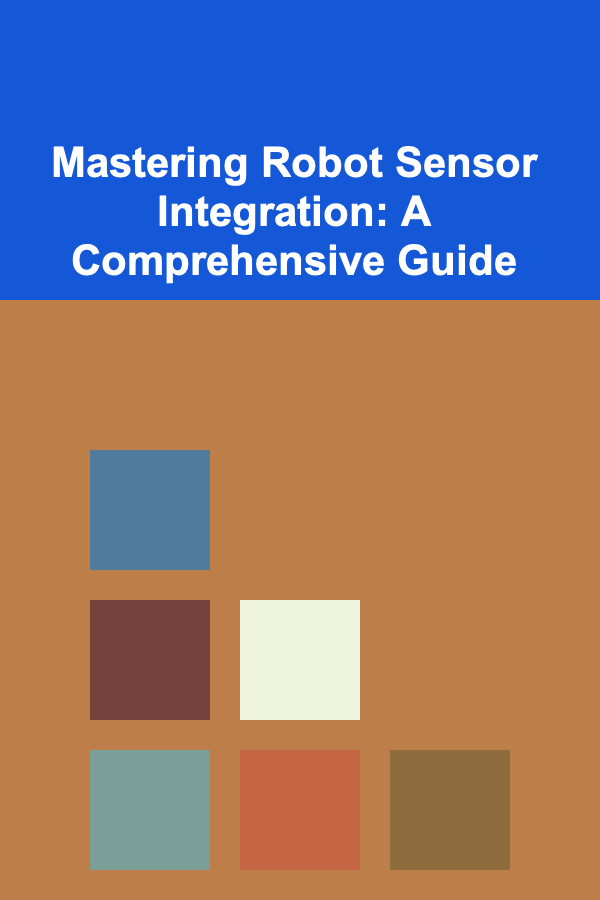
Mastering Robot Sensor Integration: A Comprehensive Guide
ebook include PDF & Audio bundle (Micro Guide)
$12.99$6.99
Limited Time Offer! Order within the next:

Introduction: The Sixth Sense of Robotics
Robotics is rapidly transforming industries, from manufacturing and logistics to healthcare and agriculture. At the heart of every capable robot lies its ability to perceive and interact with the environment. This perception is achieved through sensor integration, the process of incorporating sensors into a robot's system to provide it with real-time data about its surroundings. Mastering robot sensor integration is crucial for building robots that are not just automated machines but intelligent collaborators capable of adapting to dynamic situations and making informed decisions.
This comprehensive guide delves into the intricacies of robot sensor integration, covering fundamental concepts, practical techniques, and advanced strategies. We will explore various types of sensors, communication protocols, data processing methods, and the challenges involved in creating robust and reliable robotic systems. Whether you are a student, a researcher, or an industry professional, this guide will provide you with the knowledge and skills necessary to navigate the complex landscape of robot sensor integration and build the robots of tomorrow.
Understanding the Role of Sensors in Robotics
Sensors act as the robot's eyes, ears, and other senses, providing vital information about the external world. This information allows the robot to understand its position, detect obstacles, recognize objects, and respond to changes in its environment. Without sensors, robots would be limited to pre-programmed tasks and unable to adapt to unexpected events.
The specific sensors required for a robot depend heavily on its intended application. For example, a robot designed for autonomous navigation in a warehouse would need sensors to detect obstacles, localize itself, and identify target locations. On the other hand, a robot used for surgical procedures would require sensors to provide precise feedback on tissue properties and instrument positions.
Here's a breakdown of some key functions that sensors enable in robotics:
- Localization and Navigation: Determining the robot's position and orientation in space, and planning a path to reach a desired destination.
- Object Recognition and Classification: Identifying and categorizing objects in the environment, such as tools, parts, or humans.
- Obstacle Avoidance: Detecting and avoiding obstacles in the robot's path to prevent collisions.
- Manipulation and Grasping: Providing feedback for precise manipulation tasks, such as picking up objects or assembling components.
- Force and Torque Sensing: Measuring the forces and torques applied to the robot's end-effector, allowing for delicate interactions and force control.
- Environmental Monitoring: Sensing environmental conditions such as temperature, humidity, light levels, and gas concentrations.
Types of Robot Sensors: A Comprehensive Overview
The world of robot sensors is vast and diverse, with a wide range of technologies available to suit different applications. Choosing the right sensor for a particular task is crucial for achieving optimal performance and reliability. Here's an overview of some of the most common types of robot sensors:
1. Position and Orientation Sensors
These sensors provide information about the robot's position and orientation in space.
- Encoders: Measure the angular position of a motor shaft or joint. They can be incremental (providing relative position changes) or absolute (providing the absolute position). Absolute encoders are generally more robust to power interruptions.
- Inertial Measurement Units (IMUs): Combine accelerometers and gyroscopes to measure acceleration and angular velocity, respectively. IMUs are used to estimate the robot's orientation and track its motion. More advanced IMUs might include magnetometers for absolute heading determination.
- Global Positioning System (GPS): Provides location data using signals from satellites. GPS is suitable for outdoor environments but may not be accurate enough for indoor applications.
- Motion Capture Systems: Use cameras to track the position of markers attached to the robot. Highly accurate but usually confined to controlled lab environments.
2. Proximity and Range Sensors
These sensors detect the presence of objects and measure their distance from the robot.
- Ultrasonic Sensors: Emit ultrasonic sound waves and measure the time it takes for the waves to bounce back. These sensors are relatively inexpensive and suitable for detecting objects at short to medium ranges. They can be affected by surface reflectivity and ambient noise.
- Infrared (IR) Sensors: Emit infrared light and measure the reflected light. IR sensors are also inexpensive and can be used for proximity detection. They are susceptible to interference from ambient light and surface properties.
- Laser Rangefinders (LIDAR): Emit laser beams and measure the time it takes for the light to return. LIDAR sensors provide accurate range measurements and can create detailed maps of the environment. They are more expensive than ultrasonic and IR sensors. 2D LIDARs are commonly used for SLAM and navigation, while 3D LIDARs can provide richer environmental information.
- Time-of-Flight (ToF) Sensors: Measure the time it takes for light to travel to an object and back. ToF sensors are generally more accurate than ultrasonic and IR sensors and less expensive than LIDAR sensors. They are often used in smartphones and depth cameras.
3. Vision Sensors
Cameras provide visual information about the environment, allowing the robot to recognize objects, track movements, and navigate.
- Monocular Cameras: Single cameras that capture 2D images. They can be used for object recognition, image classification, and visual tracking. Depth information needs to be inferred through techniques like Structure from Motion or monocular SLAM.
- Stereo Cameras: Consist of two cameras separated by a known distance. By comparing the images from the two cameras, depth information can be calculated using triangulation.
- Depth Cameras: Capture depth information directly, providing a 3D representation of the scene. Examples include structured light cameras (e.g., Intel RealSense, Microsoft Kinect) and ToF cameras. Depth cameras often provide both color and depth information, enabling rich perception capabilities.
4. Force and Torque Sensors
These sensors measure the forces and torques applied to the robot's end-effector or joints.
- Force/Torque (F/T) Sensors: Typically mounted between the robot's wrist and the end-effector, F/T sensors measure forces and torques in three axes. They are used for force control, compliance control, and detecting collisions.
- Tactile Sensors: Detect contact and measure the pressure applied to the robot's surface. They can be used to improve grasping stability and detect slippage. Tactile sensors can range from simple on/off switches to complex arrays of pressure sensors.
- Joint Torque Sensors: Measure the torque applied at each joint of the robot. Useful for estimating external forces and torques acting on the robot and for implementing advanced control algorithms.
5. Other Sensors
This category includes a variety of sensors that measure other environmental parameters.
- Temperature Sensors: Measure the temperature of the environment or the robot's components.
- Humidity Sensors: Measure the humidity of the environment.
- Light Sensors: Measure the intensity of light.
- Gas Sensors: Detect the presence and concentration of specific gases.
- Microphones: Capture audio signals, enabling voice recognition and acoustic sensing.
Communication Protocols for Sensor Integration
Once you have selected the appropriate sensors, you need to establish a communication channel between the sensors and the robot's control system. Several communication protocols are commonly used in robot sensor integration:
- Serial Communication (RS-232, RS-485): A simple and widely used protocol for transmitting data between devices. It is suitable for low-bandwidth applications and short distances. RS-485 is more robust to noise than RS-232 and allows for multi-drop configurations.
- Universal Serial Bus (USB): A versatile protocol that supports high-speed data transfer. USB is commonly used for connecting cameras, depth sensors, and other peripherals to the robot's control system.
- Ethernet: A network protocol that allows for high-bandwidth communication between multiple devices. Ethernet is commonly used for connecting robots to a network and for communicating with remote servers. Real-time Ethernet protocols (e.g., EtherCAT, PROFINET) are often used for industrial automation applications requiring deterministic communication.
- Controller Area Network (CAN): A robust protocol designed for automotive and industrial applications. CAN is used for communicating between different components of the robot, such as the motors, sensors, and control system. CANopen is a higher-layer protocol built on top of CAN that defines a standardized communication profile for industrial devices.
- Wireless Communication (Wi-Fi, Bluetooth): Allows for wireless communication between the robot and other devices. Wi-Fi is suitable for high-bandwidth applications, while Bluetooth is more energy-efficient and suitable for low-bandwidth applications. Wireless communication can simplify wiring but also introduces potential challenges related to latency, reliability, and security.
- Robot Operating System (ROS): While not strictly a communication protocol, ROS provides a powerful framework for robot software development, including a robust inter-process communication (IPC) system based on publish-subscribe messaging. ROS supports various communication transports, including TCP and UDP, and provides tools for managing communication between different robot components.
The choice of communication protocol depends on factors such as bandwidth requirements, distance, noise immunity, and cost.
Data Processing and Filtering Techniques
Raw sensor data is often noisy and unreliable. Therefore, it is essential to process and filter the data before using it for decision-making. Data processing techniques can improve the accuracy, robustness, and reliability of the robot's perception system.
1. Data Calibration
Calibration is the process of correcting systematic errors in sensor measurements. This often involves determining parameters that map raw sensor readings to physical units (e.g., converting encoder counts to joint angles, converting camera pixel coordinates to 3D world coordinates). Calibration procedures can be complex and may require specialized equipment. Proper calibration is essential for accurate and reliable sensor data.
2. Noise Filtering
Noise filtering techniques remove unwanted noise from sensor data. Common noise filters include:
- Moving Average Filter: Calculates the average of a sliding window of data points. It is simple to implement but can introduce lag.
- Median Filter: Replaces each data point with the median value of its neighbors. It is more robust to outliers than the moving average filter.
- Kalman Filter: A recursive filter that estimates the state of a system based on noisy measurements. It is particularly useful for tracking objects and fusing data from multiple sensors. The Kalman filter requires a model of the system dynamics and noise characteristics.
- Particle Filter: A Monte Carlo method for estimating the state of a system based on noisy measurements. It is more robust to non-linear and non-Gaussian noise than the Kalman filter. Particle filters are computationally more expensive than Kalman filters.
3. Data Fusion
Data fusion combines data from multiple sensors to obtain a more complete and accurate representation of the environment. Data fusion techniques can improve the robustness and reliability of the robot's perception system.
- Complementary Filter: Combines data from different sensors based on their complementary characteristics. For example, accelerometer data (which is sensitive to high-frequency vibrations) can be combined with gyroscope data (which is prone to drift) to estimate orientation.
- Extended Kalman Filter (EKF): An extension of the Kalman filter that can handle non-linear system models. EKF is commonly used for sensor fusion in robotics applications.
- Unscented Kalman Filter (UKF): Another extension of the Kalman filter that uses a deterministic sampling technique to approximate the non-linear system model. UKF is generally more accurate than EKF for highly non-linear systems.
4. Outlier Rejection
Outlier rejection techniques identify and remove data points that are significantly different from the rest of the data. Outliers can be caused by sensor malfunctions, environmental interference, or other factors. Simple outlier rejection methods include thresholding (removing data points outside a predefined range) and statistical methods (e.g., removing data points that are more than a certain number of standard deviations from the mean). More sophisticated outlier rejection methods can be based on machine learning techniques.
The choice of data processing and filtering techniques depends on the specific sensors used, the noise characteristics of the environment, and the performance requirements of the robot.
Practical Considerations for Robot Sensor Integration
Implementing robust and reliable sensor integration requires careful consideration of several practical factors:
1. Sensor Selection
Choosing the right sensor for the application is paramount. Consider factors such as:
- Accuracy and Resolution: How precise and detailed does the data need to be?
- Range and Field of View: How far can the sensor detect objects, and what area does it cover?
- Update Rate: How frequently does the sensor provide new data?
- Power Consumption: How much power does the sensor consume? This is especially important for battery-powered robots.
- Size and Weight: How large and heavy is the sensor? This can impact the robot's mobility and maneuverability.
- Cost: What is the cost of the sensor? Balance performance requirements with budget constraints.
- Environmental Robustness: How well does the sensor perform in different environmental conditions (e.g., temperature, humidity, dust)?
2. Sensor Placement
The placement of sensors on the robot significantly affects its perception capabilities. Consider factors such as:
- Field of View Coverage: Ensure that the sensors cover the areas of interest.
- Obstruction Avoidance: Place sensors in locations where they are less likely to be obstructed by the robot's body or other objects.
- Sensor Fusion: Position sensors strategically to enable effective data fusion. For example, placing multiple cameras with overlapping fields of view can improve depth estimation accuracy.
- Minimizing Interference: Position sensors to minimize interference from each other (e.g., avoid placing ultrasonic sensors close together).
- Accessibility for Maintenance: Ensure that sensors are easily accessible for maintenance and replacement.
3. Power Management
Sensors can consume a significant amount of power, especially high-performance sensors such as LIDAR and cameras. Implement power management strategies to extend the robot's battery life. Techniques include:
- Sensor Duty Cycling: Turn off sensors when they are not needed.
- Low-Power Modes: Utilize the low-power modes offered by some sensors.
- Efficient Data Processing: Optimize data processing algorithms to minimize computational load and power consumption.
4. Cable Management
Proper cable management is essential for preventing cable entanglement and damage. Use cable ties, cable trays, and strain relief techniques to secure cables and prevent them from interfering with the robot's movement.
5. Software Integration
Developing robust and reliable software for sensor integration is crucial. Consider factors such as:
- Real-Time Performance: Ensure that the sensor data is processed in real-time to enable timely responses.
- Error Handling: Implement robust error handling mechanisms to deal with sensor failures and data inconsistencies.
- Modularity and Reusability: Design the software in a modular and reusable way to facilitate future development and maintenance.
- Testing and Validation: Thoroughly test and validate the sensor integration system to ensure that it meets the performance requirements.
- Using a Robotics Framework: Leverage existing robotics frameworks like ROS to simplify sensor integration and development. ROS provides drivers for many common sensors and a powerful ecosystem of tools and libraries.
Advanced Sensor Integration Techniques
Beyond the fundamental concepts, there are several advanced techniques that can further enhance robot sensor integration:
1. Sensor Fusion with Machine Learning
Machine learning algorithms can be used to fuse data from multiple sensors in a more sophisticated way. For example, a neural network can be trained to predict the state of the environment based on data from multiple sensors. This approach can be particularly useful for handling complex and non-linear relationships between sensor data. Deep learning techniques, such as convolutional neural networks (CNNs), are commonly used for processing image data from cameras, while recurrent neural networks (RNNs) can be used for processing time-series data from sensors such as IMUs.
2. Active Sensing
Active sensing involves actively controlling the robot's sensors to optimize data acquisition. For example, a robot can adjust the position and orientation of its camera to obtain a better view of an object of interest. Active sensing can significantly improve the accuracy and efficiency of the robot's perception system. Techniques like next-best-view planning aim to determine the optimal viewpoint for acquiring the most informative data.
3. Simultaneous Localization and Mapping (SLAM)
SLAM is the process of simultaneously building a map of the environment and localizing the robot within that map. SLAM algorithms use sensor data to estimate the robot's pose and the location of landmarks in the environment. SLAM is essential for autonomous navigation in unknown environments. Popular SLAM algorithms include EKF SLAM, Graph SLAM, and visual SLAM (VSLAM).
4. Semantic SLAM
Semantic SLAM extends traditional SLAM by incorporating semantic information about the environment. In addition to building a geometric map, semantic SLAM also identifies and labels objects in the environment, such as doors, windows, and furniture. This semantic information can be used to improve the robot's understanding of the environment and enable more sophisticated tasks. Semantic SLAM often relies on deep learning techniques for object recognition and scene understanding.
5. Event-Based Vision
Traditional cameras capture images at a fixed frame rate, which can be inefficient and introduce latency. Event-based cameras, also known as neuromorphic cameras, only output data when there is a change in brightness at a pixel. This asynchronous data stream can be processed more efficiently and with lower latency than traditional image data. Event-based vision is particularly well-suited for high-speed applications and situations with challenging lighting conditions.
Challenges in Robot Sensor Integration
While robot sensor integration offers tremendous potential, it also presents several challenges:
1. Sensor Noise and Uncertainty
All sensors are subject to noise and uncertainty, which can affect the accuracy and reliability of the robot's perception system. Careful calibration, filtering, and data fusion techniques are required to mitigate the effects of sensor noise.
2. Data Association
When using multiple sensors, it can be challenging to associate data from different sensors with the same object or event. Data association is particularly difficult in cluttered environments with many similar objects. Techniques like the Iterative Closest Point (ICP) algorithm are used for aligning point clouds from different sensors, while Bayesian filtering can be used for tracking objects and associating sensor measurements with existing tracks.
3. Computational Complexity
Processing large amounts of sensor data in real-time can be computationally demanding, especially for complex algorithms such as SLAM and machine learning. Efficient algorithms and hardware acceleration techniques are required to meet the real-time performance requirements of robotic applications. GPUs are often used for accelerating computationally intensive tasks like image processing and deep learning.
4. Environmental Variability
The performance of sensors can be affected by changes in the environment, such as lighting conditions, temperature, and humidity. Robust sensor integration systems must be able to adapt to these changes and maintain reliable performance. Sensor calibration procedures should be performed periodically to account for environmental drift.
5. Sensor Failure
Sensors can fail due to various reasons, such as hardware malfunctions, software bugs, or environmental damage. Redundancy and fault-tolerant design techniques are required to ensure that the robot can continue to operate even if some sensors fail. Sensor fusion algorithms can be designed to be robust to sensor failures by assigning different weights to different sensors based on their reliability.
The Future of Robot Sensor Integration
The field of robot sensor integration is constantly evolving, driven by advances in sensor technology, machine learning, and robotics. Some of the key trends shaping the future of robot sensor integration include:
- More Intelligent Sensors: Sensors are becoming more intelligent, with embedded processing capabilities that allow them to perform more complex data processing tasks on-board. This reduces the computational load on the robot's main processor and enables faster response times.
- Increased Use of Machine Learning: Machine learning algorithms are playing an increasingly important role in robot sensor integration, enabling robots to learn from data and adapt to changing environments.
- Improved Sensor Fusion Techniques: Advanced sensor fusion techniques are being developed to combine data from multiple sensors in a more robust and accurate way.
- Ubiquitous Sensing: Robots are being equipped with a wider range of sensors to provide a more complete and detailed understanding of their environment.
- Cloud-Based Robotics: Cloud computing is enabling robots to access vast amounts of data and computational resources, facilitating more sophisticated sensor integration and data analysis.
- Standardization: Increased efforts are being made to standardize sensor interfaces and communication protocols, making it easier to integrate sensors from different vendors.
These trends will lead to the development of robots that are more intelligent, adaptable, and capable of performing a wider range of tasks in complex and dynamic environments.
Conclusion: Embracing the Power of Perception
Mastering robot sensor integration is essential for building the next generation of intelligent robots. By understanding the fundamental concepts, exploring different types of sensors, mastering communication protocols, and implementing robust data processing techniques, you can unlock the full potential of robotics. While challenges exist, the future of robot sensor integration is bright, with ongoing advancements promising even more capable and versatile robots. Embrace the power of perception, and embark on your journey to create robots that can truly see, understand, and interact with the world around them.

How to Share Your Wellness Space Organization Tips Online
Read More
Librarian's Toolkit: Practical Strategies for Organizing, Cataloging, and Providing Access to Information
Read More
How To Choose the Best Beer Refrigeration Solution
Read More
Feng Shui for Your Wallet: Attracting Money
Read More
Exploring the Truth Behind Secret Government Programs
Read More
10 Tips for a Sustainable Christmas Decoration Checklist
Read MoreOther Products

How to Share Your Wellness Space Organization Tips Online
Read More
Librarian's Toolkit: Practical Strategies for Organizing, Cataloging, and Providing Access to Information
Read More
How To Choose the Best Beer Refrigeration Solution
Read More
Feng Shui for Your Wallet: Attracting Money
Read More
Exploring the Truth Behind Secret Government Programs
Read More